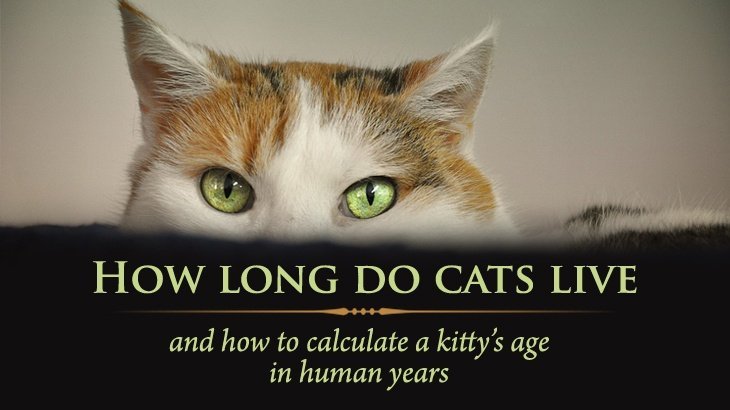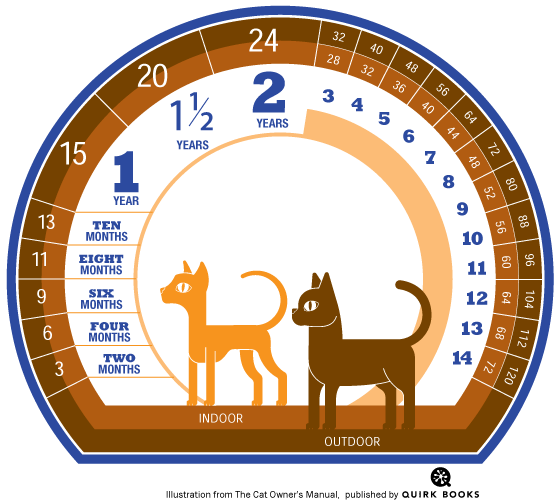Even with their whimsical, capricious, and often misunderstood ways, cats bring us joy on a daily basis.
Sure, owning a feline pet might cause you troubles from time to time. But it’s all worth it after hearing your kitty’s soft purring when you snuggle with it after a long and tiresome day at the office.
Every pet parent out there dreads the day he or she has to say goodbye to their fluffy pal. Unfortunately, even the healthiest kitties don’t live forever. They go through various growth stages just like people do, but their overall lifespans are significantly shorter than ours.
You might have heard of record-breaking kitties which have lived up to 30+ years. The average cat, however, passes away at a much younger age.
Breed plays a key role in the feline longevity. The fluffy Ragdoll, for example, can live up to 25 years.
How Long Do Cats Live?
Lifespan depends on various factors. For starters, there’s a huge difference between the lifespan of an indoor cat and the feral one on the streets.
A typical domestic cat which resides safely indoors may live 12-15 years. On the other hand, a stray or feral cat will likely live around 4-6 years out in the wild.
What Factors Play Into Longevity?
As we mentioned above, there are various factors that influence every cat’s lifespan. We’ll review the crucial ones below.
Breed
Breed plays an intrinsic role in a cat’s longevity. Designer and exotic breeds are usually shorter-lived than their more common domestic counterparts. The Sokoke, for example, is one of the shorter-lived designer felines.
Large domestic breeds like the American Shorthair, Russian Blue, and Siamese tend to live for 15-20 years. The lifespan of the popular Abyssinian and Oriental, which are notoriously active and playful breeds, is 10-15 years.
DNA Heritage
Unfortunately, there’s no such thing as a genetically pure feline. Even if your fluffy pal is the spawn of pedigreed parents from a famously healthy bloodline, the DNA heritage of its distant ancestors might make it prone to suffering from various diseases.
Health risks are higher in adopted cats because shelters can’t give you extensive information about the kitty’s parents and DNA heritage.
Food
It’s crucial to remember that nutrition is vital for any feline breed. High- quality cat food is of intrinsic importance for your pet’s longevity.
Specialized cat food meets specific feline dietary requirements,improves the cat’s overall health, and helps your pet grow into a happy, thriving, and satisfied furball.
Overall Maintenance
Cat food isn’t enough to ensure your precious pet will live longer. Their overall maintenance should never be neglected.
This means that you shouldn’t neglect daily grooming sessions. Not paying attention to de-shedding results in hairball build-ups, which can have fatal consequences. Using improper brushes will harm the skin and fur coat of your pet, which they serve as the cat’s main protective layer against environmental conditions.
Cats do clean themselves, but that’s not enough.
You need to keep your home clean, well-aired, and free of germs because even indoor kitties can develop cat allergies. And these allergies can severely shorten your furry pal’s life. Lastly, baths and nail clipping are essential when it comes to feline maintenance.
Spaying / Neutering
Spaying and neutering are considered taboo by some pet parents. Nevertheless, countless reports show that spayed females and neutered tomcats tend to live longer.
Why is that? Spayed/ neutered cats don’t go into heat. As such, they are less likely to roam restlessly, suffer from anxiety or frustration-induced depression, get into fights with other cats, contract fleas, and face other problems while trying to find a mate. On top of that, the procedure reduces the risks of ovarian and testicular cancer.
How Do You Tell A Cat’s Age?
If you don’t know your cat’s exact age, there are some things which can help you guess. Vets often check the following telltale aspects when determining a feline’s age – teeth, eyes, fur, skin, and muscles.
Teeth
A cat’s teeth are quite different from human teeth. Felines are carnivorous creatures. As such, their teeth are sharp and designed to cut through meat instead of to grind the food. Kitties also use their teeth for grooming purposes, so their pearly whites can easily wear down.
Older and senior cats not only have stained incisors and molars, but they also have tartar build-ups. Missing teeth, cavities, dark stains, and gum disease are indicators for older age. Seemingly healthy teeth with little or no staining mean the cat is around 1-2 years old.
Of course, if a pet parent maintains the dental hygiene of the cat, its teeth might trick you into thinking the furball is much younger.
Eyes
A cat’s excellent eyesight is what makes these creatures such notable hunters. As with humans, feline vision worsens over time. Smooth irises, bright and clear eyes, and little or no tearing/ discharge are indicators for young age.
On the other hand, poor eye care may result in problematic eyes at a younger age. Nevertheless, cloudiness, jagged irises, and impaired vision are always a telltale sign for declining years.
Fur coat
We all want our beloved furballs to have healthy, shiny, soft fur, but regardless of the care we lavish on our kitties, their skin and fur coat suffer as they age.
Dry, flaky, and coarse fur is a usual sign for old age. Visible patches, thinned hair, and graying strands indicate that the cat is well-advanced in years. Some breeds like the Sphynx have more problematic skin and fur coats. As such, harsh weather conditions affect them more easily than other breeds and may trick you into thinking the cat is older.
Muscles
Some breeds are more muscular by default. Nevertheless, as felines get older, they start losing their well-defined muscle tone. Elder cats are bonier, whereas seniors often display signs of hanging skin. Kittens and young cats are better built and more muscular due to being more active than their adult counterparts.
Of course, various diseases, boredom, starvation, or overfeeding can easily result in emaciation or obesity in any age group. Thus, poor or well-defined muscle tone isn’t always a proper indicator for a kitty’s age.
How To Calculate A Cat’s Age In Human Years
It’s only natural for every pet parent to want to know how old their kitty is in terms of human years. So, how can you calculate your cat’s age in typical human years?
The seven-year rule
You have probably heard of the so-called seven-year rule. In fact, you might have even seen it on a chart in a vet’s offices.
Truth be told, the seven year-rule is false.
This popular misconception basically tricks you into thinking that you should multiply your cat’s current age by seven in order to get its real age in human years. Don’t believe this myth!
Ok then, how do cats really age?
Most of us perceive cats in three ways – kittens, adults, and seniors. But there’s so much more to it. As the kitten grows bigger and into adulthood, it actually goes through the equivalent of 15 human years in it’s first year alone.
The first (and most important) year of a cat’s life equals 15 human years.
During the first two months of kittenhood your feline furball is already three years old in terms of human years. And by the time it reaches two calendar years, it’s already nearly 24 years old. After it passes the two-year mark, it ages nearly four years per each calendar year.
In other words, by the time five calendar years have passed, your cat will be 36 years old.
However, outdoor cats age faster than domestic ones because they are far more affected by their environment and living conditions. As such, a five-year-old outdoor kitty could easily be 48 years old.
So, let’s sum it up. During the first couple of years of a feline’s life it ages rapidly. After that the aging process slows down to 4 people years per 1 cat year.
Calculation chart
As you can see from the calculation chart above, both indoor and outdoor kitties age the same during the first two years of their lifespan. After these two years have passed, the outdoor cat’s age accelerates faster than the one kept indoors.
You can use the chart to calculate your own kitty’s approximate age in human years.
However, as we mentioned above, this chart cannot be applied to every single feline furball out there. If you happen to adopt a stray feral cat after it has reached adulthood, its aging will slow down. High-quality cat food, an indoor home environment and proper care will be significantly better for your cat and, as a result, it may very well live longer.
Regardless of their mischievous nature and short life expectancy, cats make our world a better place. If you wish to own a feline pal, treat it with all the love and affection you can give. It will cherish you for all your efforts for the rest of its lifetime.


